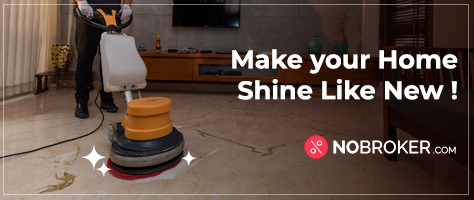Your Feedback Matters! How was this Answer?
Shifting, House?
✔
Lowest Price Quote✔
Safe Relocation✔
Professional Labour✔
Timely Pickup & Delivery
Intercity Shifting-Upto 25% Off
Check Prices

Intracity Shifting-Upto 25% Off
Check Prices

City Tempo-Upto 50% Off
Book Now
Your Feedback Matters! How was this Answer?
Shifting, House?
✔
Lowest Price Quote✔
Safe Relocation✔
Professional Labour✔
Timely Pickup & Delivery
Intercity Shifting-Upto 25% Off
Check Prices

Intracity Shifting-Upto 25% Off
Check Prices

City Tempo-Upto 50% Off
Book Now
Hi Buddy,
The versatility and durability of vinyl plank flooring are well-known. It is soft underfoot while also providing a sleek, elegant finish to your space. Vinyl is a favourite flooring choice for families with children and dogs because it is moisture-resistant, stain-resistant, and noise-dampening. It is possible to learn how to glue vinyl flooring on your own.
Use the Carpenter Services of NoBroker to Install vinyl flooring in Your Home!Vinyl flooring is a terrific alternative for first-time home-improvers because it is a fraction of the expense of hardwood.
How to install glue down vinyl plank flooring:It all starts with meticulous floor preparation. Learning how to install vinyl flooring may be done over practically any clean, dry surface with the correct preparation and glue. Check for excess moisture by glueing down a 3 × 3-foot sheet of vinyl flooring and taping the edges if you want to put it over concrete. Try to pull up the vinyl after 72 hours. There is too much moisture in the concrete to install a sheet vinyl floor if it comes up easily. Vinyl can be attached directly to old vinyl, ceramic tile, and wood floors in some circumstances, but it requires special fillers and glue-down methods. For specific information on these types of installations, contact the manufacturer.
What kind of vinyl flooring glue to use?When it comes to attaching vinyl floors, acrylic-based adhesives are particularly efficient and sturdy. Heat-resistant, temperature-tolerant, and moisture-resistant, acrylic-based adhesives are ideal for a variety of applications.
How to glue vinyl:Remember to start in the centre of the room rather than the corners while learning how to lay vinyl plank flooring with a glue-down method. Find the room's centre and draw a line using your chalk and straightedge.
Divide your room into four equal quadrants by drawing a second line at a right angle to the first.
Measure the distance parallel to the plank's direction from the centre point to the wall. Divide the measurement by the plank's width. If the last board needs to be reduced to less than half its original width, adjust the central point as necessary.
With a trowel, apply the manufacturer's recommended glue to the subfloor, beginning in the centre and working outward towards the required region.
Allow the adhesive to cure until it is sticky but still cloudy or hazy in appearance. Allowing the adhesive to sit for too long will cause it to turn transparent.
If the glue gets on the top surface of a vinyl plank, wipe it away with a dry cloth as soon as possible before it dries.
Place the first board at the intersection of the two chalk lines with its short edge.
Continue laying the boards row by row, working down the parallel chalk line, and making sure the sides of each plank are flush with the adjacent plank.
Trim the border planks as needed, providing enough expansion room as advised by the manufacturer.
After installation, most glue-down vinyl plank flooring requires a floor roller to firmly and uniformly seat the vinyl planks into the adhesive. Any adhesive that gets into the joints between planks should be wiped away or peeled away with a knife.
The baseboard should be replaced now.
I would like to conclude my answer here about how to glue vinyl flooring. I hope this helps:)
Get guidance and suggestions on vinyl flooring from the specialists at NoBroker home interior services.Read More:
What Is Vinyl Flooring? Can You Put Heavy Furniture On Vinyl Plank Flooring?Your Feedback Matters! How was this Answer?
Shifting, House?
✔
Lowest Price Quote✔
Safe Relocation✔
Professional Labour✔
Timely Pickup & Delivery
Intercity Shifting-Upto 25% Off
Check Prices

Intracity Shifting-Upto 25% Off
Check Prices

City Tempo-Upto 50% Off
Book Now
Related Questions
Related Questions in Flooring and Tiling Work
Most Viewed Questions
Recently Published Questions
Authors Of The Question

0 Total Answers
Recently Answered Questions

0 Total Answers








How to Glue Vinyl Flooring?
Tina
320 Views
3 Answers
2 Year
2022-06-15T18:22:09+00:00 2022-06-15T18:22:10+00:00Comment
Share